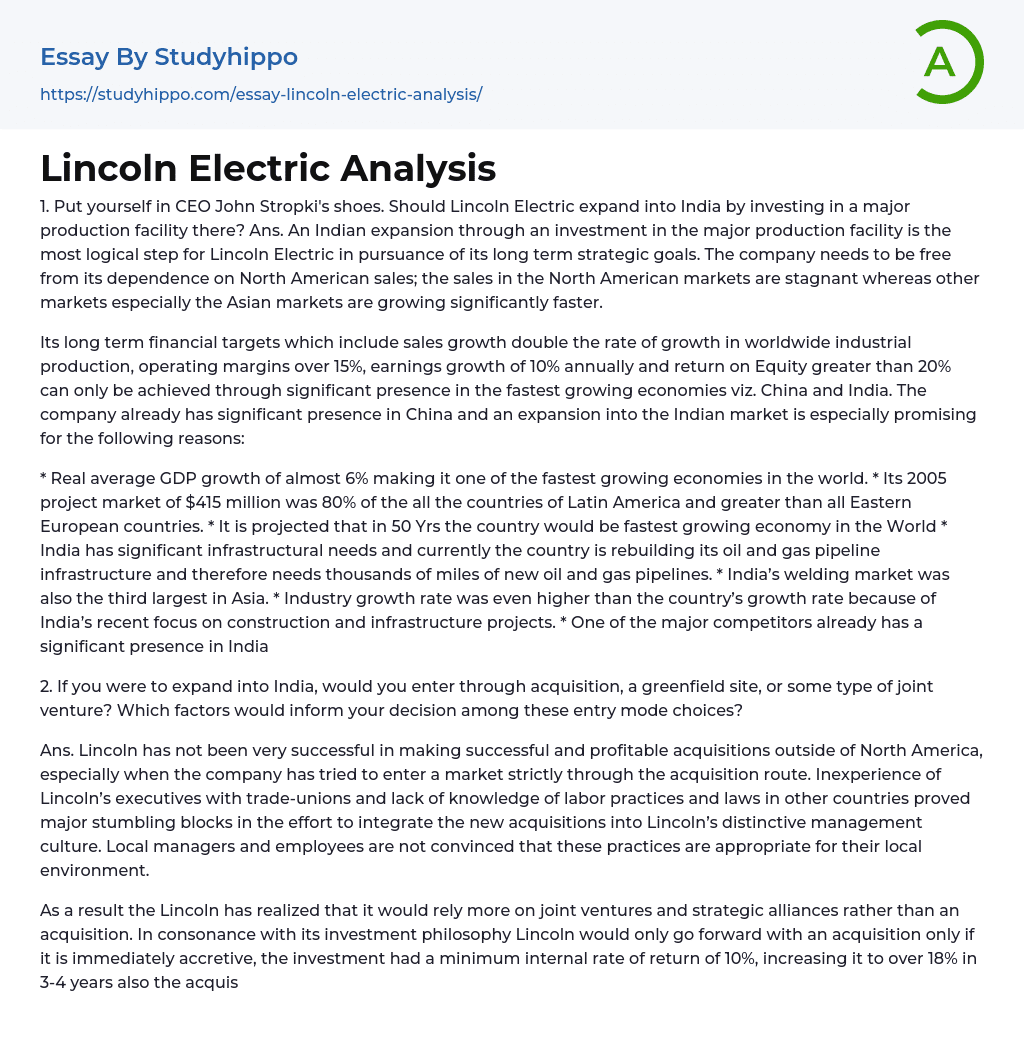1. Put yourself in CEO John Stropki's shoes. Should Lincoln Electric expand into India by investing in a major production facility there? Ans. An Indian expansion through an investment in the major production facility is the most logical step for Lincoln Electric in pursuance of its long term strategic goals. The company needs to be free from its dependence on North American sales; the sales in the North American markets are stagnant whereas other markets especially the Asian markets are growing significantly faster.
Its long term financial targets which include sales growth double the rate of growth in worldwide industrial production, operating margins over 15%, earnings growth of 10% annually and return on Equity greater than 20% can only be achieved through significant presence in the fastest growing economies viz. China and India. The company already has s
...ignificant presence in China and an expansion into the Indian market is especially promising for the following reasons:
* Real average GDP growth of almost 6% making it one of the fastest growing economies in the world.
* Its 2005 project market of $415 million was 80% of the all the countries of Latin America and greater than all Eastern European countries. * It is projected that in 50 Yrs the country would be fastest growing economy in the World
* India has significant infrastructural needs and currently the country is rebuilding its oil and gas pipeline infrastructure and therefore needs thousands of miles of new oil and gas pipelines.
* India’s welding market was also the third largest in Asia.
* Industry growth rate was even higher than th
country’s growth rate because of India’s recent focus on construction and infrastructure projects.
* One of the major competitors already has a significant presence in India
2. If you were to expand into India, would you enter through acquisition, a greenfield site, or some type of joint venture? Which factors would inform your decision among these entry mode choices?
Ans. Lincoln has not been very successful in making successful and profitable acquisitions outside of North America, especially when the company has tried to enter a market strictly through the acquisition route. Inexperience of Lincoln’s executives with trade-unions and lack of knowledge of labor practices and laws in other countries proved major stumbling blocks in the effort to integrate the new acquisitions into Lincoln’s distinctive management culture. Local managers and employees are not convinced that these practices are appropriate for their local environment.
As a result the Lincoln has realized that it would rely more on joint ventures and strategic alliances rather than an acquisition. In consonance with its investment philosophy Lincoln would only go forward with an acquisition only if it is immediately accretive, the investment had a minimum internal rate of return of 10%, increasing it to over 18% in 3-4 years also the acquisition should be done at less than 8xebitda. Since India is a booming market, Lincoln would not be able to achieve its initial investment goals, any acquisition would require paying up a premium.
One of the target companies is already owned by the competitor and other local target had a company of family ownership and dispersed ownership structure. Expansion in India through a Greenfield project
is also not a viable option since it is expected that Lincoln will face the same problems which it had faced when it tried to establish a manufacturing presence in China. The company found it harder to find competent local managers, faced difficulties in dealing with the local government authorities and also found it extremely difficult to establish distribution channels resulting in unprofitable operations for several years difficult to make operations profitable.
Therefore in the Indian context a joint venture or a strategic alliance with a significant local partner would be the most preferable route forward. The company can draw upon the vast experience of managing joint ventures and strategic alliances that it has gathered through its operations in China. In China the company had gone from being a producer of low-end consumables to embracing the most advanced welding technology all in a period of 5-10 years.
The company eventually had to proceed with a Taiwanese partnership; the partnership was able to help the company locate and retain experienced, bilingual operations managers. The company further helped Lincoln navigate the complex bureaucratic hurdles in China. A joint venture or strategic partnership in India would help the company navigate the initial hurdles that are typical to any new operations, and overtime with local experience and exposure the company can eventually embark upon establishing independent manufacturing facilities in India.
- Abraham Lincoln essays
- Andrew Jackson essays
- Barack Obama essays
- Bill Clinton essays
- Donald Trump essays
- Franklin D. Roosevelt essays
- George W. Bush essays
- George Washington essays
- James Madison essays
- John F. Kennedy essays
- Lyndon B. Johnson essays
- Richard Nixon essays
- Theodore Roosevelt essays
- Thomas Jefferson essays
- Vice President essays
- Bangladesh essays
- China essays
- Hong Kong essays
- India essays
- Japan essays
- Kuala Lumpur essays
- Malaysia essays
- Manila essays
- Pakistan essays
- Philippines essays
- Singapore essays
- Vietnam essays
- Vietnamese essays
- Atom essays
- Big Bang Theory essays
- Density essays
- Electricity essays
- Energy essays
- Force essays
- Heat essays
- Light essays
- Motion essays
- Nuclear Power essays
- Physiology essays
- Sound essays
- Speed essays
- Temperature essays
- Thermodynamics essays
- Accounting essays
- Andrew Carnegie essays
- Automation essays
- Business Cycle essays
- Business Intelligence essays
- Business Model essays
- Business Operations essays




